Balance Therapy: Use Of Balance in Physiotherapy :
In bio-mechanics, balance is an ability to maintain the line of gravity (vertical line from centre of mass) of a body within the base of support with minimal postural sway. Sway is the horizontal movement of the centre of gravity even when a person is standing still. A certain amount of sway is essential and inevitable due to small perturbations within the body (e.g., breathing, shifting body weight from one foot to the other or from forefoot to rearfoot) or from external triggers (e.g., visual distortions, floor translations). An increase in sway is not necessarily an indicator of dysfunctional balance so much as it is an indicator of decreased sensorimotor control.
Balance exercise is one of the four types of exercise along with strength, endurance, and flexibility. Ideally, all four types of exercise would be included in a healthy workout routine and AHA provides easy-to-follow guidelines for endurance and strength training in its Recommendations for Physical Activity in Adults.
They don’t all need to be done every day, but variety helps keep the body fit and healthy and makes exercise interesting. You can do a variety of exercises to keep the body fit and healthy and to keep your physical activity routine exciting. Many different types of exercises can improve strength, endurance, flexibility, and balance. For example, practicing yoga can improve your balance, strength, and flexibility. A lot of lower-body strength-training exercises also will improve your balance.
Having a good balance is important for many activities we do every day, such as walking and going up and down the stairs. Exercises that improve balance can help prevent falls, a common problem in older adults and stroke patients. They can also benefit those who are obese since weight is not always carried or distributed evenly throughout the body. A loss of balance can occur when standing or moving suddenly. Often we are not fully aware that we may have weak balance until we try balance exercises.
Cerebellar ataxia is a neurological condition in which loss of Balance and coordination is most common and Balance training is highly important.
Table of Contents
Balance systems :
The following systems provide input regarding the body’s equilibrium and thus maintain balance.
- Somatosensory / Proprioceptive System
- Vestibular System
- Visual System
The Central Nervous System receives feedback about the body orientation from these three main sensory systems and integrates this sensory feedback and subsequently generates a corrective, stabilizing torque by selectively activating muscles. In normal conditions, healthy subjects rely 70% on somatosensory information and 20% Vestibular & 10% on Vision on a firm surface but change to 60% vestibular information, 30% Vision & 10% somatosensory on an unstable surface.
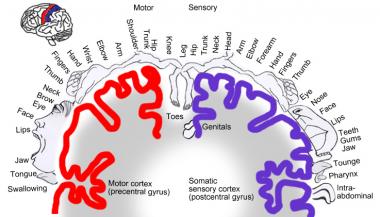
Somatosensory System
Proprioceptive information from spino-cerebellar pathways, processed unconsciously in the cerebellum, are required to control postural balance. Proprioceptive information has the shortest time delays, with monosynaptic pathways that can process information as quickly as 40–50 ms[4] and hence the major contributor for postural control in normal cond
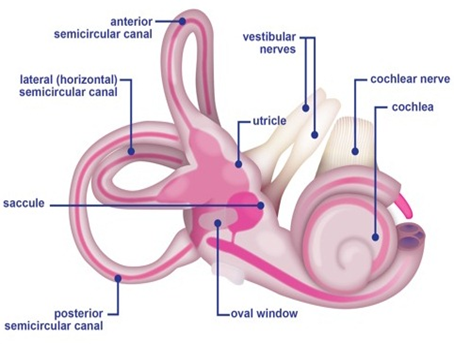
Vestibular System
The vestibular system generates compensatory responses to head motion via:
Postural responses (Vestibulo Spinal Reflex) – keep the body upright and prevent falls when the body is unexpectedly knocked off balance. Ocular-motor responses (Vestibulo Ocular Reflex) – allow the eyes to remain steadily focused while the head is in motion. Visceral responses (Vestibulo Colic Reflex) – help keep the head and neck centred, steady, and upright on the shoulders.
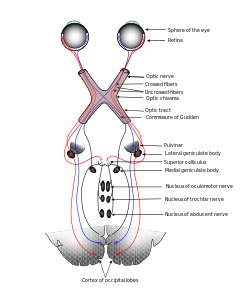
Visual System
For non impaired individuals under nornal conditions the contribution of visual system to postural control is partially redundant as the visual information has longer time delays as long as 150-200 ms. Friedrich et al. (2007) observed that adults with visual disorders were able to adapt peripheral, vestibular, somatosensoric perception and cerebellar processing to compensate their visual information deficit and to provide good postural control. In addition, Peterka (2002), found that adults with bilateral vestibular deficits can enhance their visual and proprioceptive information even more than healthy adults in order to reach effective postural stability. The influence of moving visual fields on postural stability depends on the characteristics of the visual environment, and of the support surface, including the size of the base of support, its rigidity, or compliance.
Supported, Static and Dynamic Balance
Balance can be classified into:
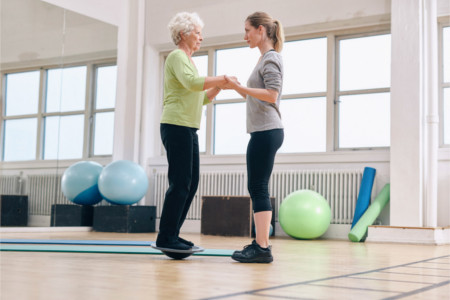
Supported Balance: It is the ability to maintain balance with external support.In this balance is maintained by external forces such like passive instruments i.e. wall support with brace and manual by the physiotherapist.
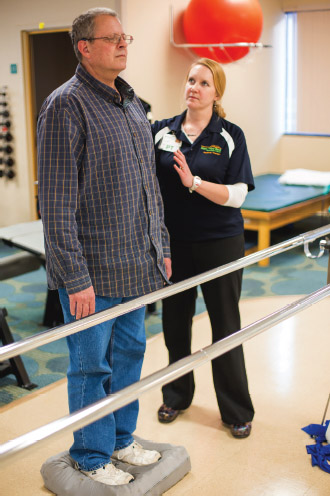
Static Balance: it is the ability to maintain the body in some fixed posture. Static balance is the ability to maintain postural stability and orientation with centre of mass over the base of support and body at rest.
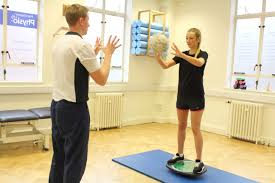
Dynamic Balance:
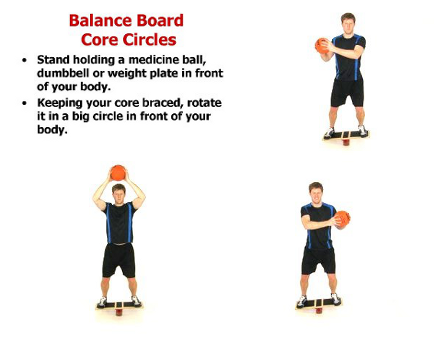
Defining dynamic postural stability is more challenging, Dynamic balance is the ability to transfer the vertical projection of the center of gravity around the supporting base of support. Dynamic balance is the ability to maintain postural stability and orientation with centre of mass over the base of support while the body parts are in motion.
Mechanisms.
The mechanisms involved in static balance were best summarized by Bannister. He noted that normal standing required:
Sufficient power in the muscles of the lower limbs and trunk to maintain the body erect. Normal postural sensibility to convey information concerning the position. Normal impulses from the vestibular labyrinth concerning the position. A central coordinating mechanism, the chief part of which is the vermis of the cerebellum. The activity of higher centers is concerned with the willed maintenance of posture.
With these mechanisms, the dynamic balance requirements can be inferred as:
Sufficient power in the muscles of the body to maintain movement and stability. Normal postural sensibility to convey information regarding movement. Normal impulses from the vestibular system and visual system concerning movement and environment. Central co-ordinating mechanism including the cerebellum and basal ganglia The activity of higher centers concerned in the willed/ involuntary maintenance of movement and stability.
Correlation between Static and Dynamic Balance
A study by Sell TC (2012) examined the relationship and differences between static and dynamic postural stability in healthy, physically active adults. Static postural stability was measured by a single-leg standing task and dynamic postural stability was measured by a single-leg landing task using the Dynamic Postural Stability Index. The author concludes that there was a lack of a correlation between static and dynamic measures. However, the increase in difficulty during dynamic measures indicates differences in the type and magnitude of challenges imposed by the different postural stability tasks.
The lack of correlation between the two different conditions is likely due to the challenge imposed on the systems necessary for the maintenance of postural stability. Maintenance of postural stability during both dynamic and static conditions involves establishing an equilibrium between destabilizing and stabilizing forces and requires sensory information derived from vision, the vestibular systems, and somatosensory feedback.
What are Balance Exercises?
Balance exercises are exercises that are prescribed by a physiotherapist to challenge your balance in order to improve it. Balance exercises will challenge the body’s vestibular system and the musculoskeletal system. They aim to improve the body’s ability to maintain posture and centre of gravity and to enhance muscle reaction time and joint proprioception (the body’s ability to recognize where the joints and limbs are in space).
Balance and proprioception exercises assisted by a musculoskeletal physiotherapist Above: Balance and proprioception exercises assisted by a musculoskeletal physiotherapist
What are the benefits of Balance Exercises?
If you have balance problems a physiotherapy assessment and balance exercises programme will be of benefit to you. There are many benefits of balance exercises which are:
Improved static balance Improved dynamic balance Improved joint proprioception Improved muscle reaction time – increasing the body’s ability to react to balance challenging situations Reduced risk of falls Improved function – tasks can be done outside of the base of support without risk Decreased muscle compensation – muscles can become overactive to compensate for poor balance Improved mobility – improved balance will increase mobility and improve energy efficiency
Areas It Targets:
Core: Yes. You need strong core muscles for good balance. Many stability exercises will work your abs and other core muscles.

Arms: No. Most balance exercises are about balancing on your feet. So unless you’re doing moves that involve your arms, or you’re holding weights, they don’t work your arms.
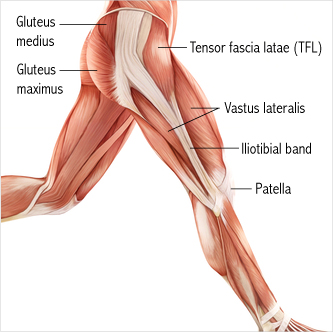
Legs: Yes. Exercises in which you balance on one leg and then squat or bend forward also work the leg muscles.
Glutes: Yes. The same balance exercises that work the legs also tone the gluteal muscles.
Back: Yes. Your core muscles include some of your back muscles.
Type
Flexibility: No. Balance training is more about strengthening muscles and improving stability than gaining flexibility.
Aerobic: It can be, but often is not. It depends on how intense the activity is. If you’re moving fast, then it may be aerobic. Slower balance exercises do not make you breathe faster or make your heart pump harder.
Strength: Yes. Many of these exercises will work your muscles, especially the muscles of your legs and core. Some moves may also use your chest and shoulder muscles, like the plank position in yoga.
Sport: No. Balance training involves a series of exercises. It is not a sport.
Low-Impact: Yes. There is no impact involved in doing balance exercises.

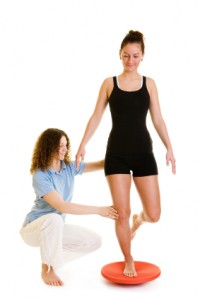
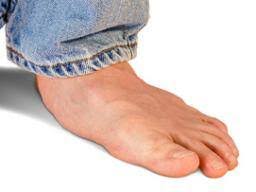

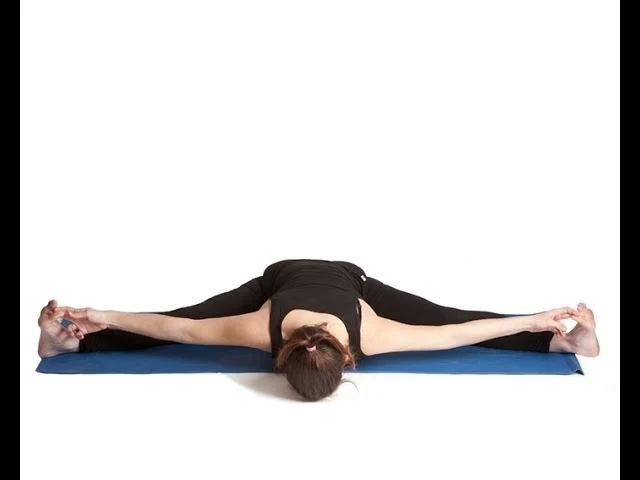
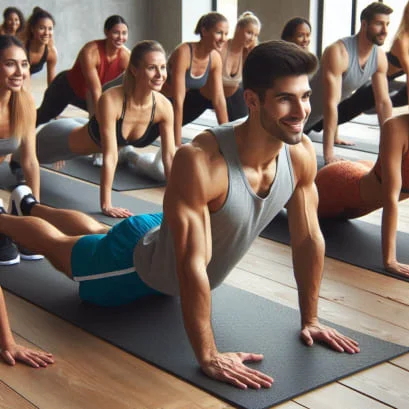
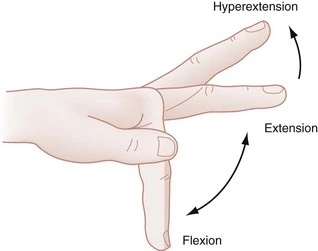
10 Comments